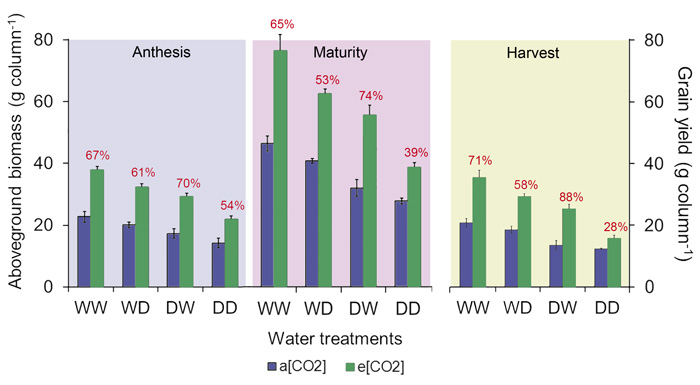| Tweet | Follow @co2science |
Paper Reviewed
Uddin, S., Löw, M., Parvin, S., Fitzgerald, G.J., Tausz-Posch, S., Armstrong, R., O'Leary, G. and Tausz, M. 2018. Elevated [CO2] mitigates the effect of surface drought by stimulating root growth to access sub-soil water. PLoS ONE 13: e0198928.
In a study conducted in a glasshouse at the University of Melbourne, Creswick, Victoria, Australia, Uddin et al. (2018) set out to investigate the interactive effects of drought and elevated CO2 on wheat (Triticum aestivum, cv. Yitpi). The plants were maintained at either ambient (400 ppm) or elevated (700 ppm during daylight hours only) CO2 levels and one of four water treatments during the course of the growing season. In the first water treatment (WW), plants were well-watered to maintain a soil water content close to field capacity across the depth of the soil column for the entire length of the experiment. In the second (WD), third (DW) and fourth (DD) water treatments, drought was imposed at stem-elongation (62 days after sowing) on the lower, upper and full layer of the soil column, respectively, by withholding 33% of the irrigation, which droughted conditions were maintained through maturity and harvest (175 days after sowing).
Not surprisingly, the results of the experiment revealed that drought negatively impacted plant photosynthesis and biomass production, while elevated CO2 enhanced it. In describing some of the CO2-induced benefits Uddin et al. say that "plants under elevated CO2 were taller, had more tillers, a larger leaf area, more heads and greater numbers of grains, which resulted in greater aboveground biomass under elevated CO2 than ambient CO2" (see Figure 1 below). Plant water use efficiency, belowground biomass and grain yield were also stimulated by elevated CO2, with the latter parameter rising by an average 63% across the four water treatments. What is more, the grain yields under elevated CO2 in the WD and DW water treatments were both higher than the well-watered treatment at ambient CO2, indicating that elevated CO2 fully compensated for the negative impacts of these two drought treatments. And although the magnitude of grain yield in the DD treatment under elevated CO2 is slightly lower than the grain yield at ambient CO2 under well-watered conditions, the researchers note that the yield values of these two treatments "were not significantly different" from one another.
Clearly, based on the results described above, rising concentrations of atmospheric carbon dioxide will increase the yield of wheat, even during times of moderate to severe drought (relative to well-watered and ambient CO2 conditions of today). And on those rare instances of extreme drought, wheat yields of tomorrow should still be similar to those observed under well-watered conditions of today, thanks to the incredible molecule -- CO2 -- that we like to call the elixir of life!

Figure 1. Aboveground biomass at anthesis and maturity, along with grain yield of wheat at maturity. Percent change in aboveground biomass and grain yield due to elevated CO2 is shown in red text at the top of each water treatment pair. Abbreviations: ambient CO2 (a[CO2]), elevated CO2 (e[CO2]), well-watered in both soil layers (WW), well-watered in upper soil layer and imposed drought in bottom layer (WD), drought in upper soil layer and well-watered in bottom layer (DW), and drought in both soil layers (DD). Adapted from Uddin et al. (2018).




